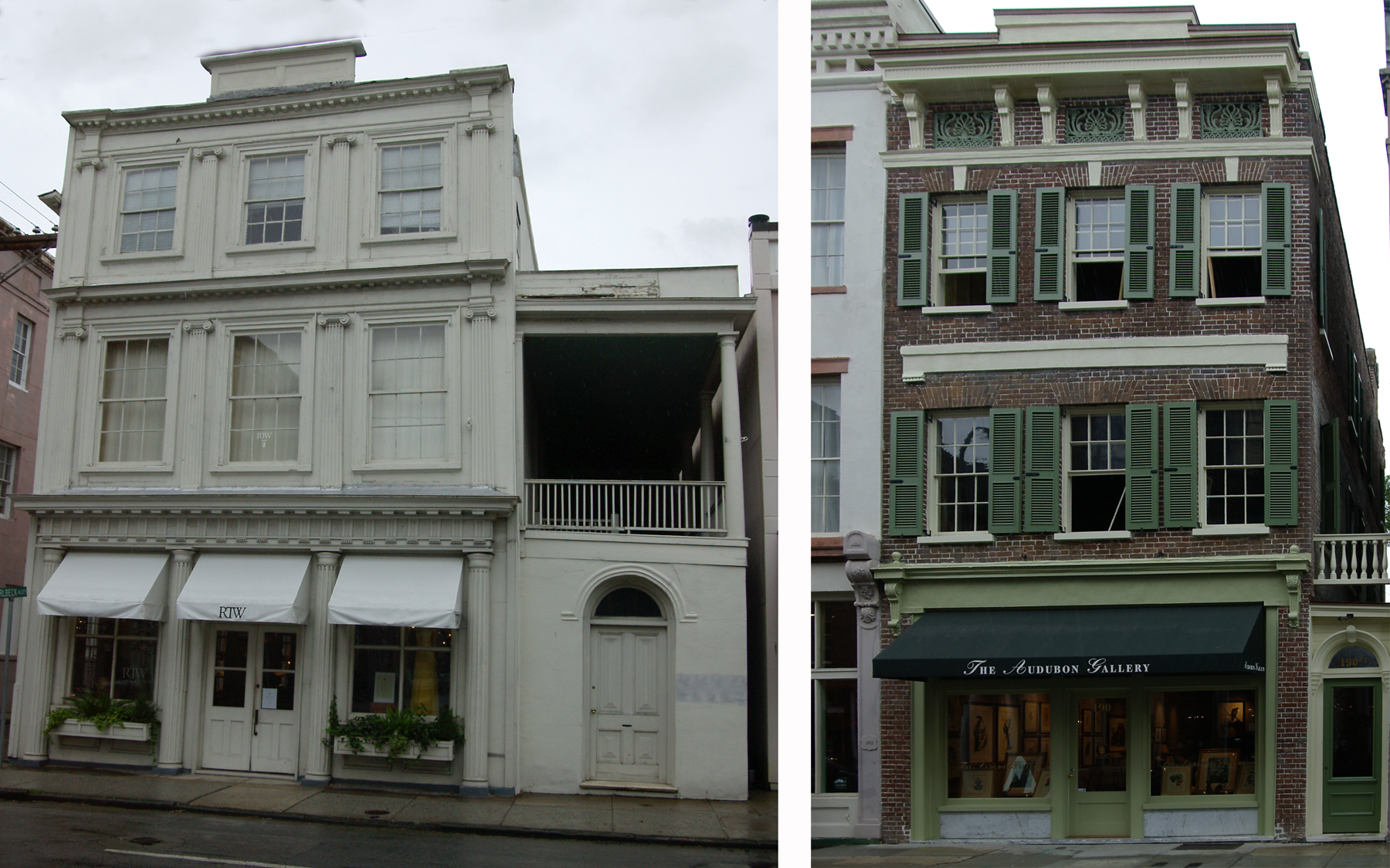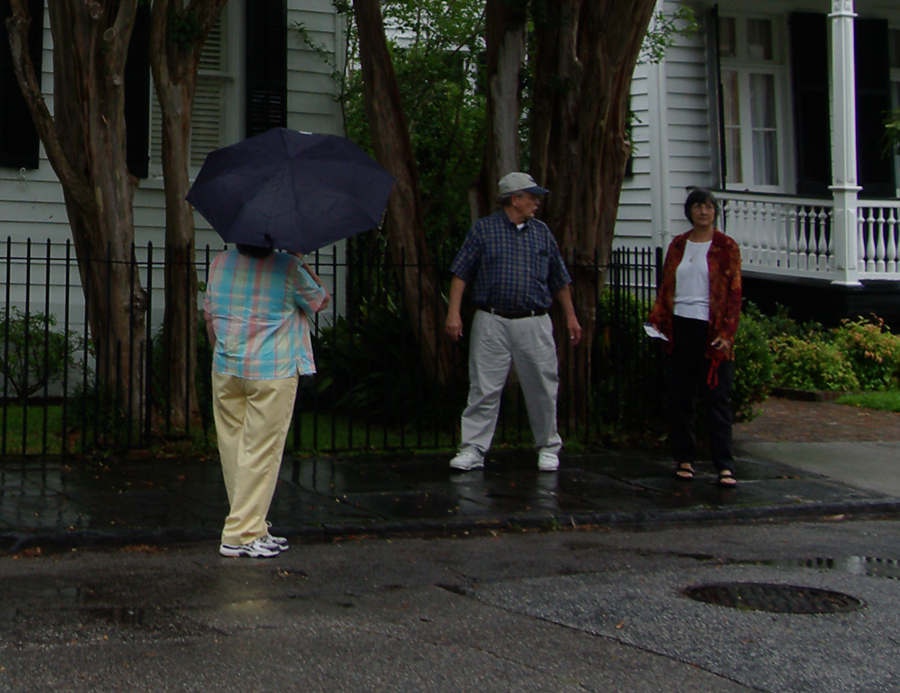 |
This is a commentary to relate the events of the 2005 Hope family reunion. Only Marion Cone, Sue, Dot and I made it this year. You guys missed a great time. After a great seafood dinner on Friday evening, we spent Saturday walking around Charleston in the rain. Well, driving between places, then walking around in the rain. We first visited the Aiken-Rhett house at 48 Elizabeth St. Beauregard had his headquarters here for much of the time he was in Charleston. This is where, presumably, our (my generation's) great grandfather, George Henry Hope Sr. worked as a clerk in the Adjutant General's office.
|
 |
After the Aiken Rhett house, we drove over to Savage Street and saw all of the places where George Henry and Eliza lived during their period in Charleston. First was 20 Savage Street. This was the first place they lived and appeared to be the largest of the several Charleston houses they lived in. The typical Charleston house is built narrow and deep (well, relatively). This reduced the street frontage which was the basis on which property was taxed at the time these houses were being built. Each house typically had four rooms, two down and two up. There was typically a large porch along one side with a solid door fronting on the street. I expect much of the living was done on the porches.
|
 |
We moved on to 22 Savage Street - literally next door. This one has lost it's porch but that allows us to see the "real" front door which traditionally opened from the porch to the house. We can also see that this one has retained it's four room configuration, although there has been something (probably a kitchen/dining area) added to the rear. This was pretty common with these houses. Most of them had several rooms added to the rear and/or the side rear.
|
 |
From there we meandered up to 25 Savage Street. It took a while since it was two houses up and across the street (chuckle). 25 Savage St. is significant because this is where they were living when Eliza and, probably, George Henry Sr. died. Dot and I were allowed to go into this house several years ago when we were on a pilgrimage to Charleston and it is really not large at all. It's had rooms added to both floors at the rear and has an unusually large side yard or garden. The gate that you can see at the bottom left has an ornate medallion in the center. We don't know how this house was configured when they lived here but it seems to have a bit more room than the others in which they lived. The door to the porch can just be discerned behind the crepe myrtle tree and the main door into the house from the porch can also be seen. George Henry and Eliza lived in Charleston for about ten or twelve years and, during that time, they had at least five different addresses on Savage St. George Henry and Eliza never owned any of these homes. They may have moved often seeking lower rents or more space - although the area was rebuilding after a fire several years earlier so they may have just been moving to newer homes as they became available.
|
 |
Next, we re-crossed the street and went another couple of houses up to 28 savage Street. This house is much like the others but has had the porch remodeled significantly. Note that the first floor porch is opened up, is not raised above the ground and a large part of the second floor porch has been converted to a room. The first floor porch treatment is pretty unusual I think - based on the houses I noticed. All of them had the porches raised well above ground level. I suspect the original porch was about the level of the brick pilasters under the columns.
|
 |
So, then on to 36 Savage Street where we find a really interesting little house. I don't recall the order in which they lived at these addresses but I think this one was intermediate. I would guess that this house has been significantly modified. I suspect that the front of the house was removed along with the porch so that it sits back from the street and sidewalk. This is definitely not the general configuration for any
other houses along this street. Also note that there are only three windows in the front section of the house. There have been several rooms added at the rear also.
|
 |
We left Savage Street and went back to town center to look up 186 (left) and 190 (right) King Street where George Henry was listed as boarding. I Presume that Eliza lived in these houses with him. These appear to be the original buildings.
|
 |
We left King Street and went on a search for the original Planter's Hotel. The current Planter's Hotel is unrelated to the original one where George Henry and Eliza were staying when James Thomas Hope (named for his grandfather) was born in 1866. The old Planter's Hotel building was restored some time ago as the Dock Street Theater. The Dock Street Theater opened at this site in 1737. The Dock Street Theater was the first theater building in America designed solely for theatrical
performances. It was presumed burned in the great 1740 fire that burned much of the
area (the French Quarter). The Planter's Hotel was built on the site around 1800 and was the premier hotel in Charleston for 60 years. It fell into ruin sometime after the War of Northern Aggression (but obviously not before 1866). The building was restored in the 1930s using federal funds and post depression work programs. The inside was rebuilt in the mode of an existing English theater but I believe the exterior was left as it was as the Planter's Hotel. The theater re-opened in 1937 with a presentation of the same play (a farce) that was presented two hundred years earlier at it's original opening. At any rate, this is where George Henry and Eliza's second child was born in 1866.
|
 |
As an aside, we rode the entire length of Bull Street since we have learned that Thaddeus Constantine Sobieski owned several lots on this street. We can truthfully say we rode by this property. Our quest for George Henry and Eliza's residences in Charleston over, we decided to check out the City Market. After roaming around for a while, we had Ben and Jerry's ice cream, then drove across the Cooper river to Patriot's Point from where the ferry to Fort Sumpter departs. Fort Sumpter was General Beauregard's headquarters for some period of time during his tenure in Charleston. George Henry presumably worked there also while on detached duty as a clerk in Beauregard's command. We toured the fort but none of the original living and working quarters are left. The Fort was the site of the first battle of the War of Northern Aggression and was re-taken by the federals late in the war. It was largely destroyed in the process. The original fort had a large bank of rooms across one side - presumably where Beauregard had his offices - but they are no longer extant.
After riding the ferry back to Patriot's Point in a driving rain on the open upper deck - hey, we ain't wimps (grin) - we had a group dinner at a local steak house. This was the last event in the 2005 Hope Family Reunion. Y'all missed a great time and interesting re-visitations of a large number of family sites. Hope to see you next year!
|








